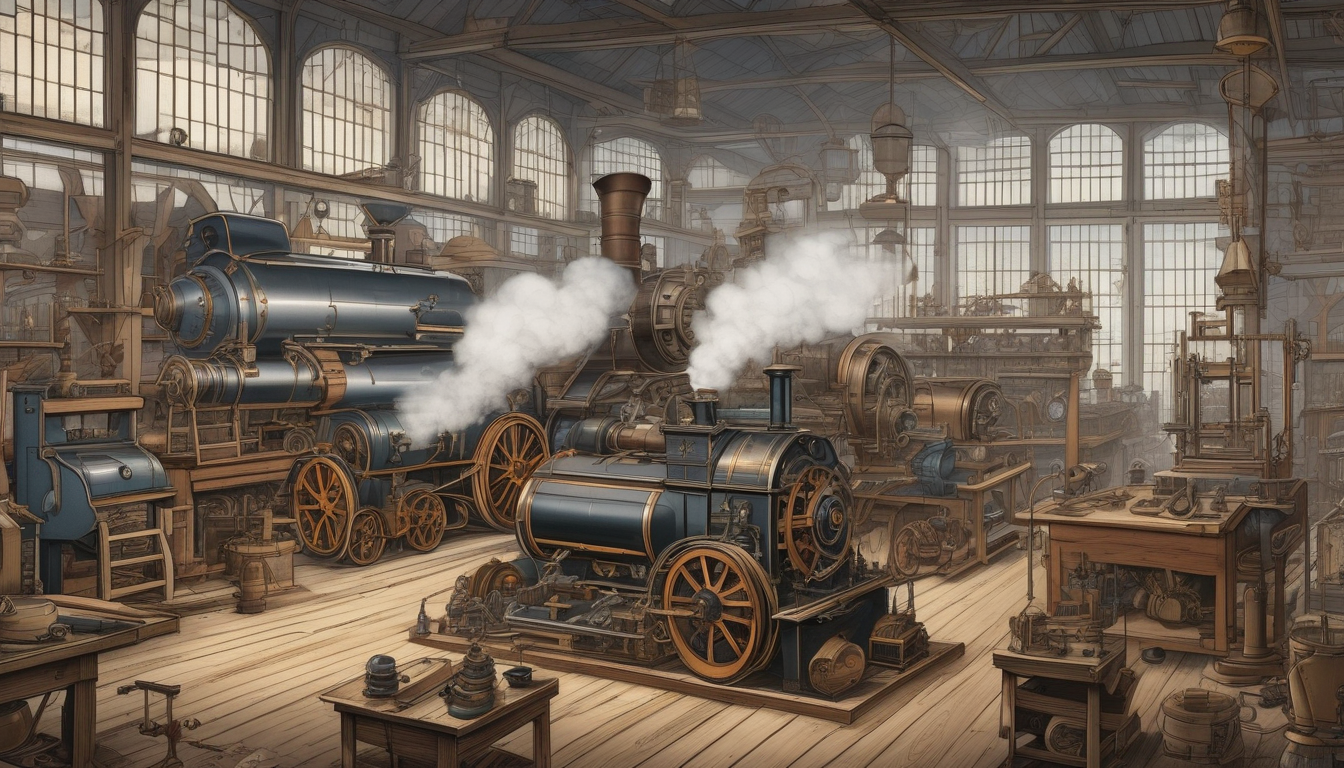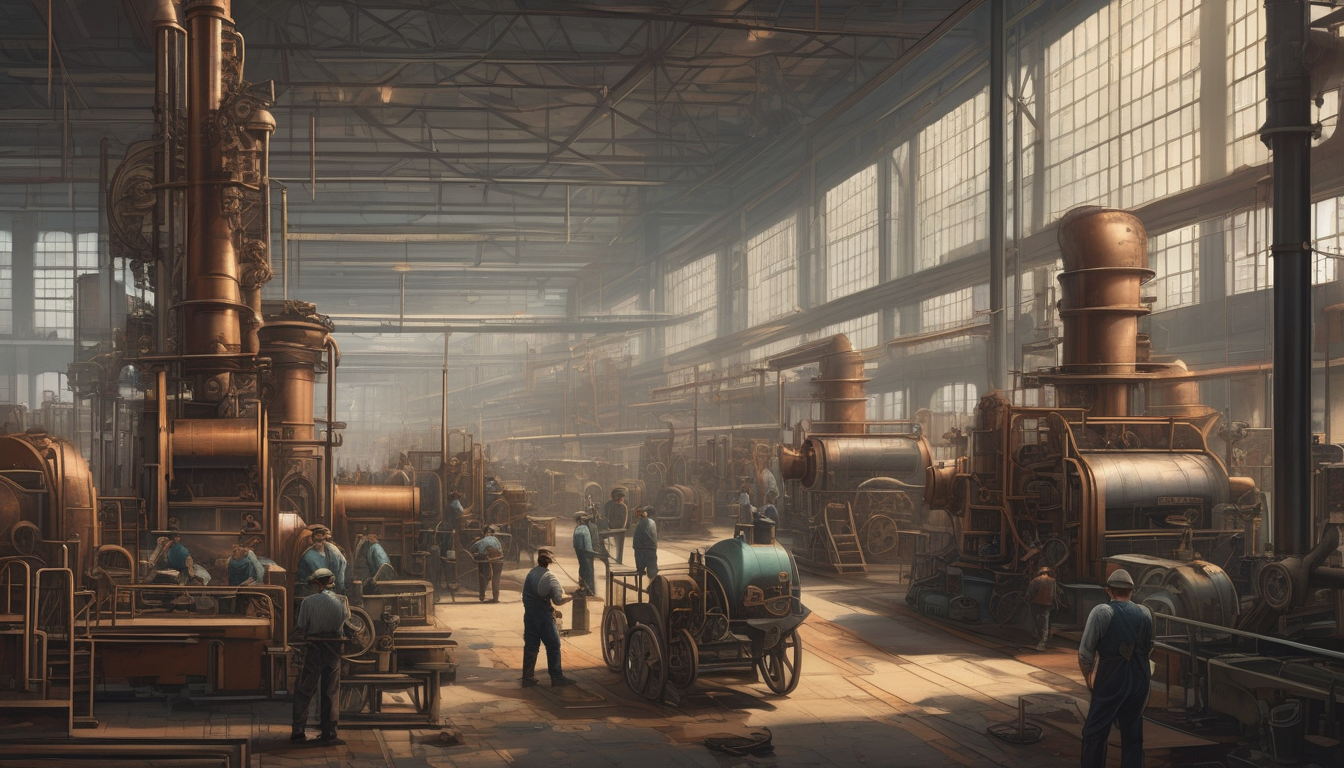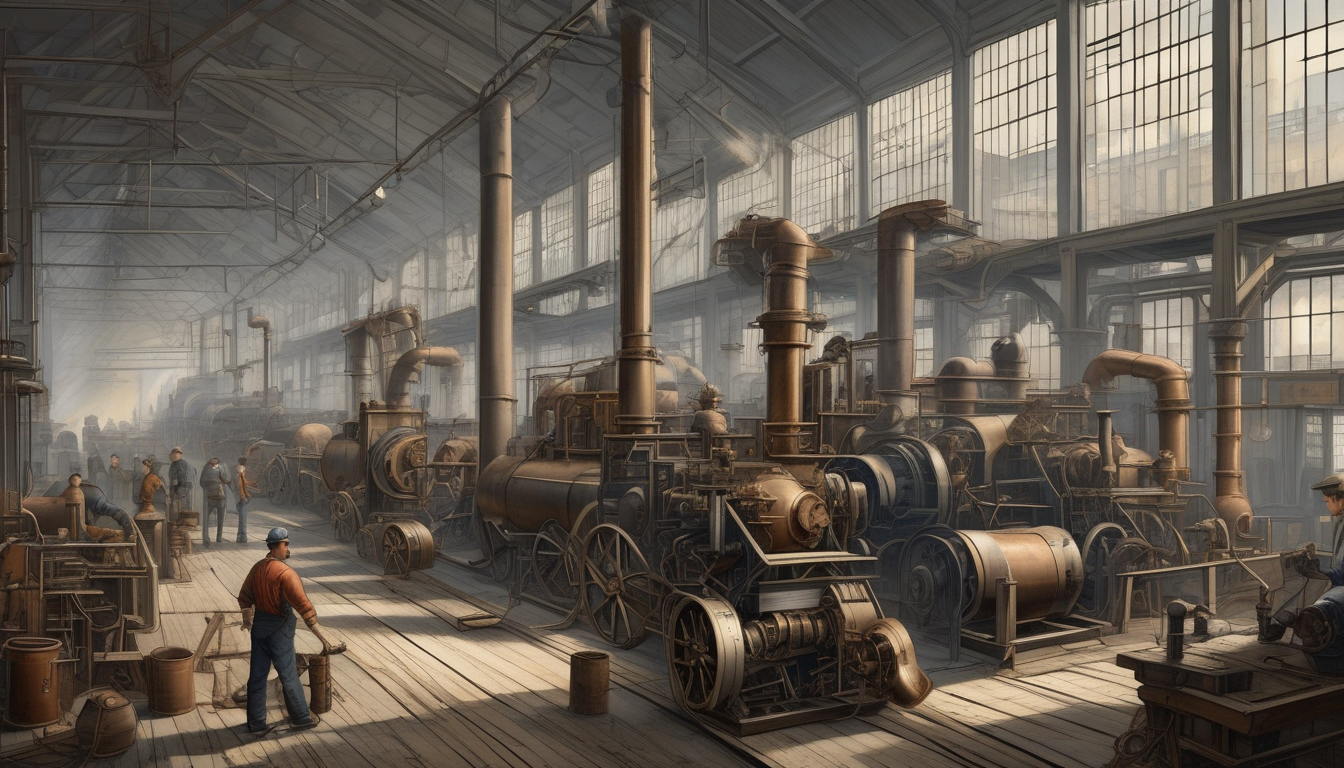The Industrial Revolution was a remarkable period that reshaped the very fabric of society. It wasn’t just about machines clanking away in factories; it was a transformational wave of innovation that changed how people lived and worked. Imagine a world where everything was done by hand, and suddenly, machines took over—this was the essence of the revolution. The shift began in the late 18th century, primarily in Britain, and it was fueled by a series of groundbreaking technological advancements.
At its core, the Industrial Revolution was driven by a combination of scientific principles and human ingenuity. Innovations in agriculture, such as crop rotation and selective breeding, significantly boosted food production. This agricultural boom meant fewer people were needed on farms, leading many to seek work in the burgeoning factories. The result? A dramatic shift in population dynamics, with rural folks flocking to urban centers in search of jobs and better opportunities.
As factories sprang up, the demand for efficient production methods skyrocketed. Inventions like the steam engine, spinning jenny, and power loom revolutionized industries by enhancing productivity. These machines operated on principles of mechanics and thermodynamics, which allowed them to perform tasks that were previously unimaginable. The steam engine, in particular, became the heartbeat of the revolution, powering everything from factory machinery to locomotives, making it possible to transport goods faster than ever before.
But it wasn’t all smooth sailing. The rapid industrialization brought about significant social changes. Many workers faced long hours in dangerous conditions, sparking the early labor movements that fought for better rights and safety standards. Urbanization led to crowded cities, and while it created economic opportunities, it also introduced challenges like pollution and inadequate living conditions.
Ultimately, the Industrial Revolution laid the groundwork for the modern world. It established the foundations for contemporary economies and technological advancements, proving that with innovation and the application of scientific knowledge, humanity could achieve remarkable feats. As we reflect on this era, we can appreciate how far we’ve come and the lessons we’ve learned along the way.

Origins of the Industrial Revolution
The Industrial Revolution began in the late 18th century, marking a significant turning point in history. It was a time when traditional handcrafting methods were replaced by new manufacturing processes. This transformation was not just a random occurrence; it was the result of a combination of factors that set the stage for modern industrial society. Innovations in agriculture, manufacturing, and transportation played a pivotal role in this evolution. Imagine a world where the pace of life was dictated by the seasons and the whims of nature. Now, picture that world being flipped upside down by machines and technology!
One of the driving forces behind the Industrial Revolution was the Agricultural Revolution. Advancements in farming techniques, such as crop rotation and selective breeding, led to increased food production. This surplus meant fewer people were needed in rural areas, prompting many to seek opportunities in burgeoning cities. The result? A massive migration of laborers ready to fill the factories that were sprouting up like mushrooms after rain.
Moreover, the demand for goods surged as populations grew. People wanted more than just the basics—they wanted textiles, tools, and other products that could only be produced efficiently in factories. This demand fueled innovations that changed the landscape of production. Take a look at the table below for a glimpse of some key factors that contributed to the origins of this remarkable era:
| Factor | Description |
|---|---|
| Agricultural Innovations | Improved farming methods led to increased food supply and population growth. |
| Technological Advancements | Inventions such as the steam engine revolutionized production methods. |
| Transportation Improvements | Development of roads and canals facilitated the movement of goods. |
| Urbanization | People flocked to cities for work, creating a labor force for factories. |
In summary, the origins of the Industrial Revolution were rooted in a complex interplay of agricultural advancements, technological innovations, and societal changes. This era set the foundation for a world that would become increasingly interconnected and industrialized, paving the way for the rapid advancements that followed. It was a time of explosive growth and transformation, shaping not just industries but the very fabric of society itself.

Key Inventions and Innovations
The Industrial Revolution was nothing short of a technological explosion, fueled by groundbreaking inventions that transformed industries and the way people lived. Among these innovations, the steam engine and the spinning jenny stand out as pivotal developments that reshaped production methods. Imagine a world where machines could do the work of dozens of people; that’s the reality these inventions created. They not only enhanced efficiency but also sparked a wave of creativity and further innovations across various sectors.
One of the most significant inventions was the steam engine. Developed by brilliant minds like James Watt, this machine harnessed the power of steam to operate machinery in factories. Before its invention, production was largely manual and slow, but with the steam engine, factories could run continuously, increasing output exponentially. This was like flipping a switch from candlelight to electric light—everything changed overnight!
The steam engine didn’t just revolutionize manufacturing; it also transformed transportation. With the introduction of steam-powered locomotives and ships, the movement of goods became faster and more efficient than ever before. Trade routes expanded, and markets flourished as products could now travel long distances in a fraction of the time. Picture a bustling marketplace where fresh goods arrive daily instead of weekly—this was the new normal, thanks to steam power.
Textile manufacturing, a cornerstone of the Industrial Revolution, saw remarkable innovations as well. The introduction of machines like the spinning mule and the power loom drastically increased the speed of cloth production. These inventions not only boosted output but also lowered labor costs, allowing for cheaper textiles that were more accessible to the public. Imagine a time when the fabric you wore was a luxury, and then suddenly, it became an everyday commodity!
In summary, the key inventions of the Industrial Revolution were not just technological advancements; they were the catalysts for a new era. They changed the landscape of society, economy, and daily life, paving the way for future innovations that would continue to shape our world.
The Steam Engine
The steam engine was nothing short of a game-changer during the Industrial Revolution. Developed by brilliant minds like James Watt, this remarkable invention transformed the way industries operated. Imagine a world where factories could run continuously, churning out goods at an unprecedented pace—this was the reality brought forth by the steam engine. It harnessed the power of steam to drive machinery, making production faster and more efficient than ever before.
The steam engine’s impact reached far beyond the factory walls. It revolutionized transportation by powering locomotives and steamships, which drastically reduced travel time and opened up new markets. Picture a bustling train station in the 19th century, with trains arriving and departing, carrying goods and people across vast distances. This newfound mobility not only facilitated trade but also connected communities like never before.
To understand its significance, let’s break down the steam engine’s contributions:
- Increased Production: Factories could operate machinery more efficiently, leading to higher output and economic growth.
- Enhanced Transportation: Steam-powered vehicles enabled quicker transport of raw materials and finished goods.
- Job Creation: The rise of factories and transportation systems created numerous job opportunities, drawing people from rural areas to urban centers.
As we reflect on the steam engine’s legacy, it’s clear that it was more than just a machine. It symbolized a shift in human ingenuity and the beginning of a new era. The principles of thermodynamics and mechanics that underpinned its design not only improved efficiency but also laid the groundwork for future technological advancements. The steam engine was the spark that ignited the flames of the Industrial Revolution, forever altering the course of history.
Impact on Transportation
The Industrial Revolution didn’t just change how goods were produced; it fundamentally transformed how they were transported. Imagine a world where moving from one place to another took days or even weeks. With the advent of the steam engine, this narrative changed dramatically. Locomotives and steamships became the new champions of transportation, allowing for the swift movement of people and commodities across vast distances.
Before the steam engine, transportation relied heavily on horses, carts, and sailing ships, which were often slow and limited in their capacity. The introduction of steam-powered vehicles meant that goods could be transported faster and more efficiently than ever before. For instance, a steam locomotive could cover distances that would take a horse-drawn carriage days to complete, cutting travel time significantly. This not only made trade more viable but also opened up new markets.
Furthermore, the development of railways created a network that connected cities and regions like never before. This expansion of transportation infrastructure led to a boom in trade and commerce, as businesses could now reach customers in previously inaccessible areas. The chart below illustrates the exponential growth in railway mileage during the 19th century:
| Year | Railway Mileage (in miles) |
|---|---|
| 1825 | 5 |
| 1850 | 6,000 |
| 1870 | 30,000 |
| 1900 | 200,000 |
As cities expanded and populations grew, the need for efficient transportation became even more critical. Steamships, which could navigate rivers and oceans, played a crucial role in international trade. They enabled countries to exchange goods on a global scale, fostering economic interdependence and cultural exchange.
In essence, the impact of the Industrial Revolution on transportation was like a ripple effect, enhancing not just the speed and efficiency of moving goods but also reshaping economies and societies. It laid the groundwork for the modern transportation systems we rely on today, making the world feel smaller and more interconnected.
Advancements in Textile Manufacturing
The Industrial Revolution marked a transformative era for textile manufacturing, introducing groundbreaking innovations that reshaped the industry. As factories began to sprout like mushrooms after rain, traditional handcrafting methods were quickly replaced by mechanized processes. This shift not only enhanced efficiency but also drastically increased the volume of production. Imagine a world where a single machine could do the work of dozens of skilled artisans—this was the reality brought forth by inventions like the spinning mule and the power loom.
The spinning mule, invented by Samuel Crompton, was a game-changer. It combined the features of the spinning jenny and the water frame, allowing for the production of finer and stronger yarn. This innovation meant that factories could produce textiles at an unprecedented scale, meeting the growing demands of a burgeoning market. In fact, the output of cotton yarn alone skyrocketed, leading to a significant drop in prices and making textiles accessible to the masses.
On the other hand, the power loom, developed by Edmund Cartwright, automated the weaving process, allowing for faster and more consistent fabric production. Before this invention, weaving was labor-intensive and time-consuming. With the power loom, the speed of textile production increased dramatically, enabling factories to churn out fabrics that were not only cheaper but also of higher quality. As a result, the textile industry became a cornerstone of the Industrial Revolution, fueling economic growth and transforming social dynamics.
To illustrate the impact of these advancements, consider the following table that summarizes key inventions and their effects:
| Invention | Inventor | Impact |
|---|---|---|
| Spinning Mule | Samuel Crompton | Increased yarn production and quality |
| Power Loom | Edmund Cartwright | Automated weaving, faster production |
In conclusion, the advancements in textile manufacturing during the Industrial Revolution were not just about machines; they represented a shift in societal norms and economic structures. The ability to produce textiles efficiently and at scale laid the groundwork for modern consumer culture, setting the stage for future innovations in various industries. As we reflect on this era, it’s clear that these developments were pivotal in shaping the fabric of society itself.
Scientific Principles at Work
The Industrial Revolution was not just a series of inventions; it was a profound transformation fueled by scientific principles that changed the way we understand and interact with the world. At the heart of this revolution were concepts like thermodynamics and mechanics, which provided the foundation for designing machines that could operate more efficiently and reliably. Imagine the steam engine, for instance. It wasn’t just a metal box that burned coal; it was a complex system that utilized the laws of thermodynamics to convert heat into mechanical energy. This was revolutionary!
One of the key scientific principles that emerged during this time was the law of conservation of energy, which states that energy cannot be created or destroyed, only transformed. This principle guided inventors and engineers in optimizing their machines, ensuring that they made the most out of the energy inputs. As a result, factories could produce more goods with less energy, driving down costs and increasing profitability.
Furthermore, the application of mechanics allowed for the development of machines that could perform tasks with precision and speed that human labor simply couldn’t match. For example, the introduction of the power loom transformed the textile industry by automating weaving processes, which not only increased output but also improved the quality of textiles produced. This was a game-changer for manufacturers and consumers alike!
To illustrate the impact of these scientific principles, consider the following table that highlights some of the notable inventions and their underlying scientific concepts:
| Invention | Scientific Principle | Impact |
|---|---|---|
| Steam Engine | Thermodynamics | Increased production capacity |
| Power Loom | Mechanics | Automated textile production |
| Spinning Jenny | Mechanical advantage | Enhanced yarn production |
In conclusion, the scientific principles that underpinned the Industrial Revolution were not merely theoretical; they were practical tools that innovators used to reshape industries and societies. The synergy between science and technology during this period laid the groundwork for the modern world we live in today, proving that understanding the world around us can lead to extraordinary advancements.

Labor and Social Changes
The Industrial Revolution was not just about machines and steam; it was a seismic shift in the very fabric of society. As factories sprang up, they became the beating heart of urban centers, pulling people away from the quiet, pastoral life of the countryside. This migration was like a flood, as individuals and families sought better opportunities in cities, leaving behind their agrarian roots. But with this surge came a host of challenges that reshaped social dynamics and labor practices.
Imagine a bustling factory floor, filled with the clatter of machinery and the hum of human activity. Workers, often from rural backgrounds, found themselves in a new world where the clock dictated their lives. Long hours became the norm, stretching from dawn until dusk, as the demand for production skyrocketed. The irony? While these factories promised economic prosperity, they often delivered grueling conditions that tested the limits of human endurance.
Working conditions in factories were frequently harsh and dangerous. Employees, including women and children, toiled under the watchful eyes of supervisors, facing risks from unguarded machinery and toxic substances. The reality was stark: many workers endured injuries or illnesses that could easily have been prevented. This led to the rise of early labor movements, as individuals banded together in a fight for their rights. They demanded better wages, reasonable hours, and safer working environments. This collective action was a pivotal moment in labor history, laying the groundwork for future reforms.
As cities expanded to accommodate the influx of workers, urbanization brought both opportunities and challenges. New neighborhoods emerged, but so did overcrowding and inadequate living conditions. Many families found themselves in cramped housing, struggling to make ends meet. The social fabric was frayed, with stark contrasts between the wealthy industrialists and the laborers who powered their fortunes. Despite these struggles, this era also sparked a sense of community among workers, fostering solidarity and a shared identity.
In conclusion, the labor and social changes brought about by the Industrial Revolution were profound and multifaceted. They transformed not just how people worked, but how they lived and interacted with one another. The legacy of these changes continues to influence labor rights and social structures today, reminding us of the resilience of the human spirit in the face of adversity.
Working Conditions in Factories
The rise of factories during the Industrial Revolution marked a significant shift in how people worked and lived. While these factories were hubs of innovation and productivity, the working conditions were often far from ideal. Imagine stepping into a factory filled with the relentless noise of machines, the air thick with dust, and the constant rush of workers trying to meet demanding quotas. It was a world where long hours and hazardous environments became the norm rather than the exception.
Workers, including many children, toiled for up to 16 hours a day, often in poorly ventilated spaces. The lack of safety regulations meant that accidents were common, with injuries from machinery being a frequent occurrence. To illustrate this grim reality, consider the following table that highlights some of the key issues faced by factory workers:
| Issue | Description |
|---|---|
| Long Working Hours | Workers often labored for 12-16 hours daily, leaving little time for rest. |
| Unsafe Conditions | Machinery was unguarded, leading to frequent accidents and injuries. |
| Child Labor | Many children were employed, working in harsh conditions for minimal pay. |
| Low Wages | Workers received meager pay, barely enough to support their families. |
As the industrial landscape evolved, so too did the awareness of these issues. Workers began to organize, advocating for better conditions and fair wages. Early labor movements emerged, pushing for reforms that would eventually lead to the establishment of labor laws and worker rights. This collective action was crucial in highlighting the need for change and improving the lives of countless individuals.
Despite the challenges, the struggle for better working conditions laid the groundwork for the labor rights we often take for granted today. It’s a testament to the resilience of those who fought for their dignity and rights in the face of adversity. The Industrial Revolution may have transformed industries, but it also ignited a movement for social justice that continues to resonate in today’s workforce.
Impact on Urbanization
The Industrial Revolution acted like a magnet, drawing people from the countryside into bustling urban centers. As factories sprang up, they created a demand for labor that rural areas simply couldn’t fulfill. This mass migration transformed small towns into thriving cities almost overnight. Imagine a quiet village suddenly filled with the sounds of machinery, bustling workers, and the vibrant energy of a growing population. It’s hard to believe how quickly this shift occurred!
With urbanization came a host of changes—both exciting and challenging. On one hand, cities became hubs of innovation and economic opportunity. People flocked to these urban areas in search of jobs, hoping to improve their lives and those of their families. On the other hand, the rapid growth led to overcrowding, inadequate housing, and strained public services. Many found themselves living in cramped conditions, often in tenements that lacked basic amenities.
Urban living conditions during this period were a mixed bag. While some enjoyed the benefits of proximity to work and commerce, others faced grim realities. The streets were often filled with pollution from factories, and the lack of proper sanitation led to health crises. The following table illustrates some of the key challenges and opportunities that arose from urbanization during the Industrial Revolution:
| Opportunities | Challenges |
|---|---|
| Increased job availability in factories | Overcrowding in urban areas |
| Access to new goods and services | Poor living conditions and sanitation |
| Growth of public transportation | Health issues due to pollution |
As cities expanded, they also became melting pots of culture and diversity. People from different backgrounds came together, sharing ideas and lifestyles. This cultural exchange laid the groundwork for the modern urban environments we see today. So, while the Industrial Revolution sparked a wave of urbanization, it also highlighted the need for reforms to improve living conditions, ultimately setting the stage for future social movements aimed at enhancing the quality of life in cities.

Legacy of the Industrial Revolution
The Industrial Revolution was not just a series of technological advancements; it was a seismic shift that altered the very fabric of society. Its legacy can be felt in various spheres of modern life, from the economy to social structures. Imagine living in a world where the hustle and bustle of factories replaced the serene sounds of nature. This transformation paved the way for the modern industrial landscape we know today.
One of the most significant impacts of the Industrial Revolution was the birth of the modern economy. It introduced concepts such as mass production and economies of scale, which allowed goods to be produced more efficiently and at a lower cost. This shift not only made products more accessible to the average person but also fueled consumer culture, leading to a society that thrives on consumption.
Moreover, the Industrial Revolution laid the groundwork for subsequent technological advancements. The principles of mechanics and thermodynamics that emerged from this era continue to influence engineering and technology today. For instance, the innovations in steam power led to the development of electricity generation, which has become the backbone of modern infrastructure.
However, the legacy is not solely positive. The rapid urbanization that accompanied the Industrial Revolution brought about significant challenges, including overcrowded cities and inadequate living conditions. Many people moved from rural areas in search of work, leading to a dramatic shift in demographics and social dynamics. This migration resulted in a blend of cultures but also sparked social issues that required attention and reform.
In essence, the legacy of the Industrial Revolution is a double-edged sword. It created opportunities and propelled society into a new era of innovation, but it also brought forth challenges that continue to resonate today. As we navigate the complexities of modern life, we must remember the lessons of the past and strive to create a balance between progress and the well-being of society.
Frequently Asked Questions
- What was the Industrial Revolution?
The Industrial Revolution was a period of significant technological, socioeconomic, and cultural change that began in the late 18th century. It marked the transition from agrarian societies to industrialized ones, driven by innovations in manufacturing, agriculture, and transportation.
- What were some key inventions during the Industrial Revolution?
Some of the most notable inventions included the steam engine, spinning jenny, and power loom. These innovations drastically improved production efficiency and transformed various industries, especially textiles and transportation.
- How did the steam engine impact society?
The steam engine revolutionized both manufacturing and transportation. It enabled factories to operate machinery more effectively, leading to increased production. Additionally, it powered locomotives and steamships, which facilitated trade and the movement of goods over long distances.
- What were working conditions like in factories?
Factory work during the Industrial Revolution often involved long hours, poor working conditions, and safety hazards. This led to the emergence of early labor movements advocating for better rights and improved safety standards for workers.
- What was the impact of urbanization during this period?
The Industrial Revolution spurred rapid urbanization as people flocked to cities for factory jobs. This shift created new social dynamics, opportunities, and challenges, including overcrowding and inadequate living conditions in urban areas.
- What legacy did the Industrial Revolution leave behind?
The Industrial Revolution laid the groundwork for modern economies and technological advancements. Its effects are still felt today, influencing everything from industrial practices to societal structures and ongoing technological revolutions.


